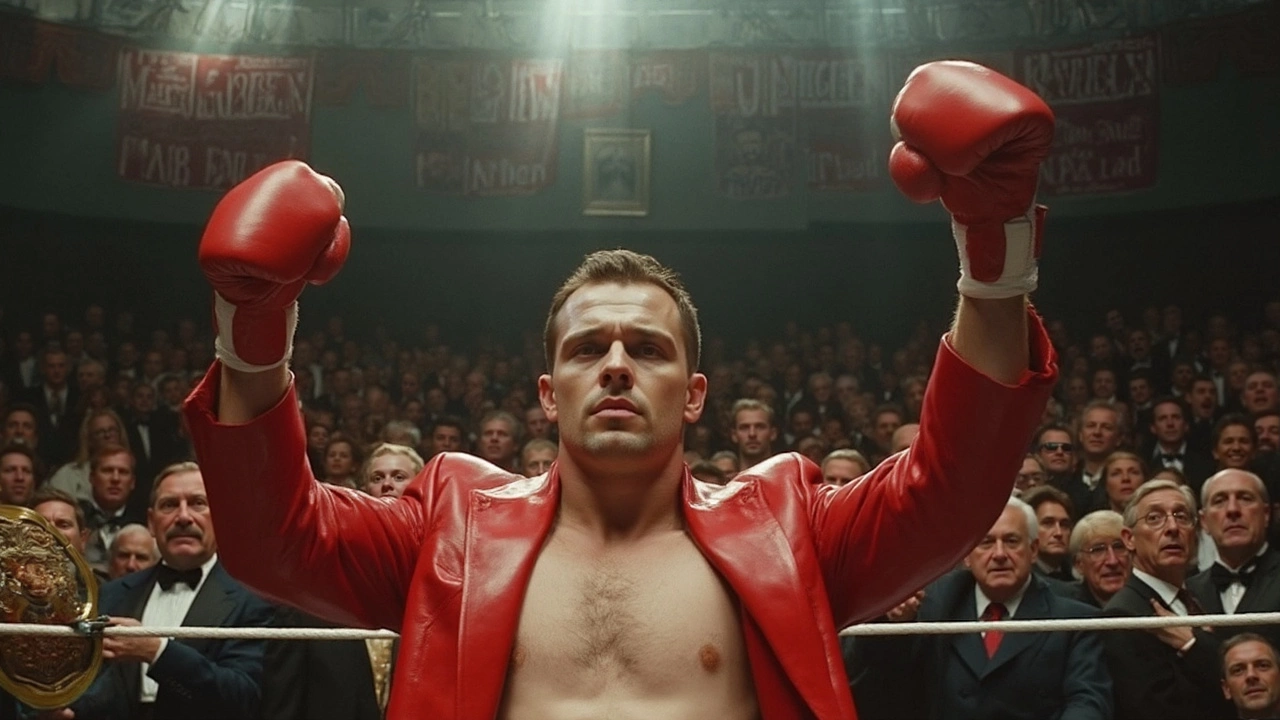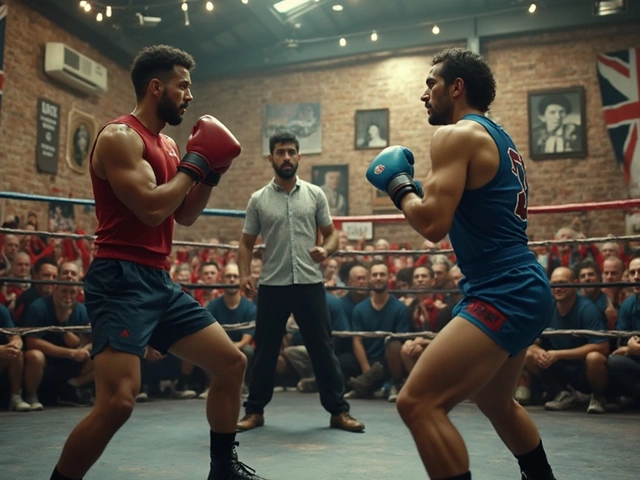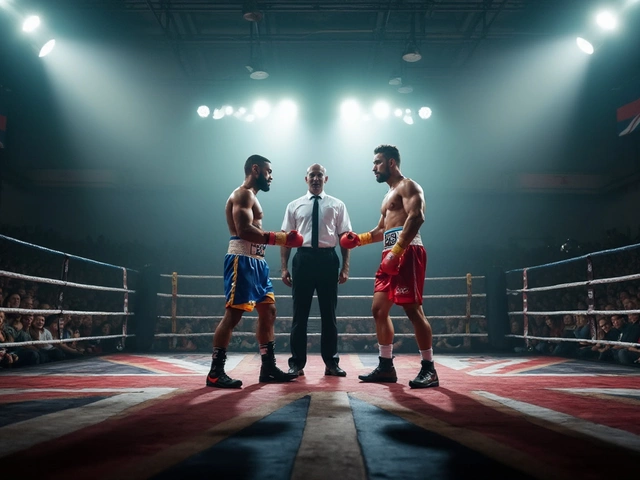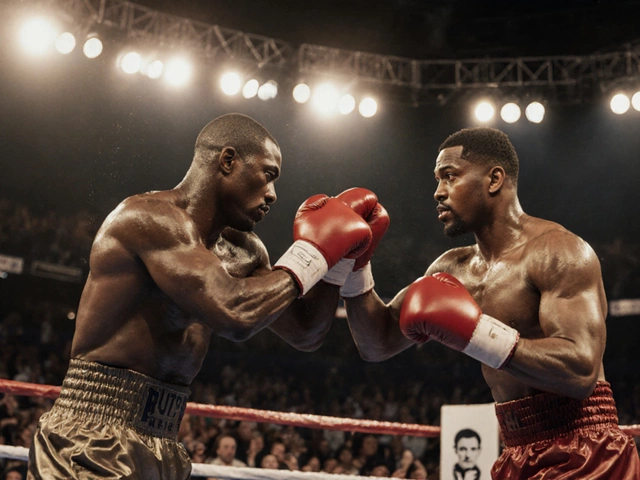Main Fight in Boxing: What It's Called and Why It Matters

If you've ever wondered what everyone tunes in for on a boxing night, it's the main fight—what people in the boxing world call the "main event." This is the bout everyone talks about, gets hyped for, and pays big money to see. It's usually the fight at the top of the night’s card, featuring the most popular or skilled fighters. Whether it’s a world title match or a long-awaited rivalry, the main event is what sells tickets and pay-per-view buys.
The term “main event” isn’t just thrown around. Promoters use it for the biggest fight on the lineup, the one placed last. If you see a poster with two names printed in the largest font, that’s your main event. Sometimes you’ll also hear “headliner” or even “feature bout,” but “main event” is the go-to term all over boxing—from local clubs to massive arenas.
- What Do We Call the Main Fight?
- Main Event vs Co-Main Event
- Why the Main Event Gets Top Billing
- Career Impact for Fighters
- Promoters’ Strategy: Building the Card
- Tips for Fans: Watching the Main Event
What Do We Call the Main Fight?
Boxing nights aren’t all created equal, and everyone tunes in for the main fight. The official name for this showdown is the main event. This is the fight that gets advertised the most, has the top billing on the poster, and ends the night’s action. If it’s a world title or a big-name rivalry, you’ll see it put front and center everywhere.
You might also hear people call it the “headliner.” Still, if you buy tickets or order a pay-per-view, you’ll see the words “main event” used nearly every time. Promoters, media, and fans all use this term because it keeps things clear—everyone knows exactly which fight is supposed to have the most hype. In tournament-style cards, some might also say “feature bout,” but that’s less common nowadays.
Here’s something interesting: the main event is almost always the last fight of the night. By saving it for last, organizers make sure the crowd energy peaks at the right time. This also gives TV networks the best slot for high viewership. For example, the Mayweather vs. Pacquiao fight in 2015, one of the highest-grossing boxing events ever, was the main event and scheduled last in the evening, going live right after all the preliminaries wrapped up.
To clear up the terms, here’s a quick breakdown:
- Main Event: The top-billed fight, usually last on the card and drawing the most viewers.
- Headliner: Another word for main event, often used in promotions.
- Feature Bout: Sometimes used for high-level fights, but not always the last or most important.
Want proof about its importance? Check out some numbers from major recent events:
| Event | Main Event Fighters | Estimated Viewers |
|---|---|---|
| Mayweather vs. Pacquiao (2015) | Floyd Mayweather, Manny Pacquiao | ~4.6 million PPV buys |
| Canelo vs. GGG II (2018) | Canelo Álvarez, Gennady Golovkin | ~1.1 million PPV buys |
| Joshua vs. Klitschko (2017) | Anthony Joshua, Wladimir Klitschko | ~90,000 stadium attendance |
So when you hear talk about the main event or main fight in boxing, just know it’s the bout that everyone came for. It’s what makes the whole night special.
Main Event vs Co-Main Event
There’s always some confusion about how the main event and the co-main event work in a boxing night. The main event is the fight that headlines the show—it’s the top attraction. The best names, the belts, the real hype, all center on this bout. Put simply, if you’re seeing ads or hearing buzz, it’s almost always about the main event.
But what about the co-main event? That’s actually the fight that comes right before the main event. It’s second in the lineup, usually featuring fighters that are close to the top, promising up-and-comers, or sometimes established pros who aren’t quite at the main event level. Promoters use co-main events to keep viewers hooked and build excitement for the main fight.
Here’s a quick comparison of what usually separates a main fight from a co-main event:
- Main Event: Top stars, title fights, highest stakes, biggest global interest.
- Co-Main Event: High-quality fight but not as major—great for showing off future stars or #1 contenders.
- Main Event is always last, co-main is second-to-last.
Major promotions like Top Rank and Matchroom love to stack their cards this way. At a typical big boxing event, ticket sales often spike in the last hour—right when fans expect to see the main and co-main events. According to a DAZN broadcast stat, over 60% of all live pay-per-view traffic jumps online in the hour before the main event kicks off.
If you want to experience the best of boxing, don’t skip the co-main either. Sometimes those fights turn out just as wild, or even better, than the showdown everyone talks about at the top of the card.
Why the Main Event Gets Top Billing
The main fight—or main event—gets top billing for a simple reason: it’s what draws in fans and makes the night unforgettable. Promoters build an entire fight card just to make sure this one match gets the spotlight. You’ll see the biggest names right at the top of the poster and on every marketing ad. That’s because fighters in the main event usually have the most experience, best records, or most intense history together. When fans buy tickets or pay-per-view, it’s mostly to see who comes out on top in this clash.
Also, there’s more at stake in the main event—like world titles or all-time bragging rights. Most of the historical upsets, wild knockouts, and instant legends in boxing happened while the whole arena and millions at home watched the main event. This isn’t just about money, though cash matters a lot. The main fight is also when fighters earn the biggest purses of the night. Check out a typical payout breakdown:
| Match Position | Average Fighter Pay |
|---|---|
| Main Event | $1,000,000+ |
| Co-Main Event | $200,000 - $500,000 |
| Undercard | $10,000 - $50,000 |
Networks and promoters schedule the main event last—sometimes late at night—because that’s when audiences peak. Big casino venues, for example, love this because people keep spending money right up until the main fight ends. You probably notice, too, that the pre-fight build-up focuses on the main event almost exclusively, with press conferences, weigh-ins, and trash talk all centering around those fighters.
It’s simple: the main fight is what everyone is waiting for, and every detail of the night is designed to shine a spotlight on the main event. If you’re only going to catch one fight, this is the one you don’t want to miss.

Career Impact for Fighters
Getting a main event spot in boxing isn’t just good for the ego—it’s a career game-changer. Being chosen to headline a card means the promoters believe you can sell tickets or bring in huge TV or pay-per-view numbers. That leap to the big stage usually brings bigger paychecks and way more exposure. Canelo Alvarez, for example, rakes in tens of millions per main fight because he’s always the headliner.
Boxers who grab the main event slot often see their social media following and sponsorships explode overnight. Just look at Gervonta "Tank" Davis—the minute he started topping cards, brands lined up to work with him. Winning a high-profile main fight is also a shortcut to world rankings, championship fights, or even cross-over opportunities in movies and TV.
If you lose in a main event, the road gets steep, but it’s not all bad. Millions of eyes on your performance can mean bigger fights if you impressed the crowd, even in defeat. No joke, Andy Ruiz Jr. got another shot after losing to Anthony Joshua because he delivered an exciting show as a main eventer.
| Main Event Fight | Purse ($ Million) | TV Viewers (Approx.) |
|---|---|---|
| Canelo vs. Plant (2021) | 40+ | 800,000 PPV Buys |
| Spence Jr. vs Pacquiao (2021) | 8+ | 500,000 PPV Buys |
The bottom line? Headlining isn’t just for the limelight. The main event is the biggest shot a boxer gets to change his life—bigger wallet, bigger fame, and better fights in the future.
Promoters’ Strategy: Building the Card
Promoters put a ton of thought into how they build a boxing night. The main fight, or main event, is always the big ticket, but what comes before matters just as much for business. The goal? Keep fans pumped all night so the energy peaks when the headliners step into the ring.
First, promoters set the main event. Usually, it features two well-known fighters—maybe there’s a championship at stake, or a score to settle. After that, they fill out the rest of the card. The co-main event goes right before the main event and is often another highly anticipated matchup, but not quite as big.
Underneath, you’ll find undercard fights. These bouts are usually up-and-comers or local favorites, giving new talent a shot at some limelight. Don’t sleep on these fights; some of boxing’s best moments have happened when an underdog snatches a surprise win early in the night.
- Popular or undefeated fighters are usually matched up to attract more viewers.
- Championship or title elimination fights build higher stakes.
- Local fighters are added to pull in hometown crowds and boost ticket sales.
- Promoters sometimes sprinkle in celebrities or social media stars to grab extra attention—think of how big the hype was around Jake Paul fights.
It’s a balancing act between making the early fights entertaining and making sure nobody’s too burnt out for the feature. And there’s money on the line too: a stacked card usually means more people buying tickets or paying for pay-per-view.
| Part of the Card | Typical Role | Fighter Type |
|---|---|---|
| Main Event | Headline attraction | Champions, big names |
| Co-Main Event | Support, second biggest fight | Contenders, former champions |
| Undercard | Warm-up fights | Prospects, local favorites |
So, if you ever show up early to a boxing match, pay attention to the whole lineup, not just the main fight. Promoters craft the card to keep things exciting from the first bell to the last knockout.
Tips for Fans: Watching the Main Event
If you want to get the most out of the main event in boxing, it helps to know what to look for and how to plan your night. These fights usually don’t start right at the scheduled time. Main events often run late, especially with pay-per-view cards—sometimes you’re waiting past midnight to see the ring walks. Checking the undercard schedule and recent trends can save you hours of clock-watching. For big events, the main fight tends to start two to three hours after the first bout of the night.
Atmosphere makes a main event special. If you’re watching from home, invite friends, order some food, and follow the live commentary—either on TV or on social media. If you’re lucky enough to have a ticket, arrive early. Fighters do media interviews and there’s usually some sort of pre-fight hype or ring walk theatrics you won’t want to miss. Noise levels skyrocket as the main event draws near; arenas get loud, and even viewers at home feel the tension build on their screens.
- Look up each fighter’s stats and recent performances so you know what to expect. Sites like BoxRec list fighter records, win/loss streaks, and knockout percentages.
- Pay attention to the fight build-up stories—sometimes a main event isn’t just about skill, but also long-standing rivalries or back stories you can spot even during press conferences.
- Don’t fall for every rumor or fake streaming link online. Major main event fights usually air on official pay-per-view channels, ESPN, DAZN, or Sky Sports.
- If you want a better view at the arena, try to get seats facing the cameras; most action and famous knockouts seem to happen in those corners, according to fan surveys.
Here’s a quick breakdown of the average main event start times for top boxing cards in recent years:
| Event Type | First Fight Time | Main Event Start |
|---|---|---|
| U.S. Pay-Per-View | 7:00 PM | 11:30 PM - 12:00 AM |
| European Prime | 6:00 PM | 10:00 PM - 10:30 PM |
| Local Club Show | 5:00 PM | 8:00 PM - 9:00 PM |
Save yourself some stress—set alerts and follow official boxing social media accounts for real-time updates. That way, you don’t miss the ring walk or the first shocking punch of the main event.



